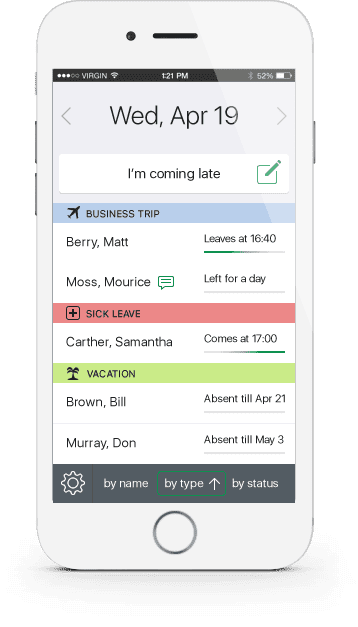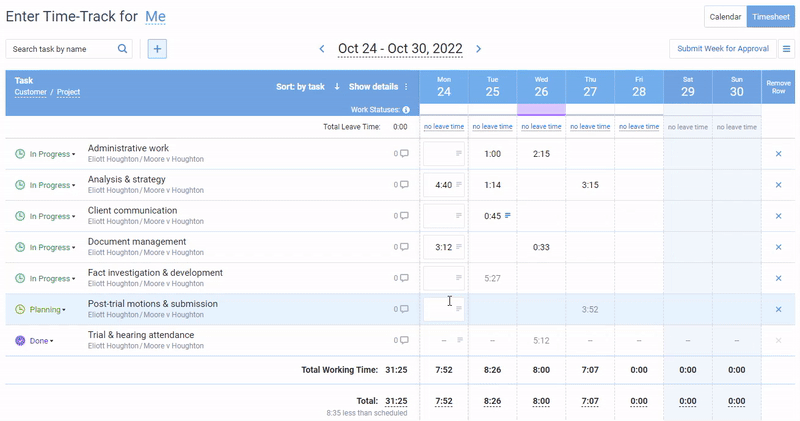Taking care of your team’s work-life balance is more than just a nice gesture – it’s a staple of effective workforce management. But how do you keep employees happy and motivated in case your workloads are frequently high and overtime work is inevitable?
Enter time off in lieu (TOIL) – this invaluable PTO arrangement will help you give employees time back and create a culture where hard work is rewarded and everyone feels valued.
Let’s dive into the world of TOIL and explore what it means for your business and your team.
What Is Time Off in Lieu (TOIL)?
Time off in lieu (or simply TOIL) is a nifty PTO benefit that lets workers convert their extra working hours into future time off instead of just additional pay. In sum, it’s like banking that overtime in the form of PTO and then drawing from that “time bank” when you need a break.
TOIL is especially useful in those roles where workloads ebb and flow unpredictably – instead of feeling overburdened during peak periods, employees can look forward to well-earned time off later. This makes TOIL a win-win for both the company and the staff as it can be used to enhance productivity and keep everyone’s stress levels in check.
Time Off in Lieu vs. Paid Overtime
In essence, TOIL and overtime pay are two disparate means to compensate your team for the extra hours worked, and there’s no straightforward way to determine which of the two is more beneficial than the other.
For example, TOIL is associated with considerable cost savings for employers as compared to paid overtime (that’s usually calculated at a higher rate than regular employee work hours).
However, in businesses where team workloads are consistently intense or when an employee has a critical role at the workplace, it would be problematic to grant them extra time off. A prolonged employee absence in such situations could disrupt your team’s workflow and slow down its performance, so paid overtime seems to be a better solution than TOIL.
The same uncertainty applies to employees as well. While some people are driven by financial gains, other prefer a healthier work-life balance. Hence, the choice between TOIL and paid overtime will depend on personal needs, interests, and preferences.
Takeaway:
Ultimately, when it comes to time off in lieu versus overtime pay, there’s no one-size-fits-all answer. Each approach has its advantages and pitfalls depending on the context.
Employers might lean towards TOIL for its cost-effectiveness, but in high-stakes environments, paid overtime can keep the wheels turning smoothly. As for employees, they will weigh financial gain against work-life balance when making their choice.
In the end, it’s all about finding what fits best for both the company and the individual.
Benefits of TOIL for Employers
- Higher overtime willingness. Employees might be more willing to take on extra work if they know they can convert that time into future days off. It’s a win-win: urgent work gets done, and employees get the time off they need.
- Increased flexibility. By giving employees an option to choose between financial compensation and extra leave hours, time off in lieu promotes greater workplace flexibility and gives you an opportunity to enhance team members’ work-life balance.
- Enhanced employee morale. The TOIL-related balance and flexibility help to make your workforce happier and more motivated.
- Financial savings. Overtime can drain a budget quickly. In contrast, TOIL arrangements allow you to save money by avoiding overtime pay while still compensating employees with highly-valued personal time.
- Better resource management. When there’s a surge in workload, TOIL provides a buffer. You can efficiently allocate human resources during high-demand periods, knowing that the balance will be achieved through compensated time off later.
- Competitive edge. Offering TOIL can attract top talent. It’s a sign of a flexible and progressive workplace that values employee wellbeing and acknowledges their hard work uniquely and meaningfully.
Benefits of TOIL for Employees
- Mental health boost. Knowing you can take a day off when needed without losing pay can significantly reduce stress and improve overall well-being.
- Higher job satisfaction. When a company has a TOIL policy, it makes employees feel that their efforts are recognized and valued, which results in greater job satisfaction.
- Lower risk of burnout. Overtime work can stress out and fatigue employees, while time off in lieu helps to counteract these risks by providing opportunities to take a break and recharge.
- More opportunities to pursue personal interests. Extra time off allows employees to indulge in hobbies or activities they love, fostering a more fulfilling life outside of work.
TOIL: Legal Challenges
Managing time off in lieu can be quite a legal labyrinth, especially when you take a look at how different countries handle it. So, let’s break it down:
In the United States, the federal law is pretty clear-cut that non-exempt employees must get their overtime pay – no ifs or buts. This means TOIL is basically off the table for them and is an option solely for exempt employees.
Now, let’s turn our gaze to Canada and the United Kingdom, where things spice up a bit.
Both countries share a somewhat similar stance: you must dish out that overtime pay unless your employees have explicitly agreed in writing to swap it for TOIL. Think of it as needing their buy-in before you can make the switch.
So, word to the wise: you can’t just shove TOIL down their throats instead of the good old overtime pay. It’s all about that mutual agreement, ensuring everyone’s on the same page.
Sample Time Off in Lieu Agreement
Want to make TOIL an official option for your employees?
First, make it clear to them that they can swap overtime pay for extra leave hours. Then, customize and use the below sample TOIL agreement to receive written consent from your staff members:
Dear [Employee Name],
We appreciate the hard work and dedication you bring to our team! As a token of our gratitude, we are excited to offer the opportunity for time off in lieu (TOIL) instead of the standard overtime pay. Below are the terms and conditions of this agreement:
Agreement to TOIL:
By signing this agreement, you consent to receive time off in lieu for any hours worked beyond your standard hours instead of receiving overtime pay.
TOIL Accrual:
For every hour of overtime worked, you will accrue equivalent time off. For example, 4 hours of overtime equate to 4 hours of TOIL.
TOIL Usage:
The accrued TOIL must be used within [6 months] of the accrual date. Any TOIL not used within this period may be forfeited, subject to manager discretion and specific circumstances.
Requesting TOIL:
Requests to use accrued TOIL should be made through the standard leave request process and must be approved by your manager in advance. We will do our best to accommodate your request based on operational needs.
Termination and TOIL:
If you leave the company before using your accrued TOIL, any remaining TOIL will be paid out at your regular rate of pay.
***
I have read and understood the terms of this TOIL agreement and agree to abide by them.
Employee Signature: ___________________
Date: ___________________
Manager’s Signature: ___________________
Date: ___________________
***
Thank you for your continued hard work!
How to Manage Time Off in Lieu Effectively: Best Practices
1. Consider all relevant policy nuances
When it comes to managing time off in lieu, there are several things you need to be on top of to ensure everything runs smoothly. So, here’s a rundown of the key points to include in your general PTO policy:
- Clear accrual guidelines. Specify how TOIL is earned. Whether it’s on an hour-for-hour basis or different ratios for different roles, clarity is crucial.
- Tracking and control. Implement a system to accurately record hours worked and TOIL earned. This could be automated software like actiPLANS or a simple, rigorous manual tracking system.
- Approval processes. Outline the procedure for taking TOIL. Is pre-approval required? And if yes, who needs to approve it? Make sure this is well-documented to avoid misunderstandings.
- Expiry and carry-over rules. Decide if TOIL can be carried over to the next calendar year or if it expires. If there is an expiry, ensure employees are aware of it well in advance.
- Usage restrictions. Lay out any restrictions for when TOIL can be taken. Certain peak times or busy seasons may have blackout periods for TOIL usage.
- Equity and fairness. Ensure your TOIL policies do not inadvertently benefit some employees over others. Fair application across all staff levels is highly recommended.
- Payouts on termination. Clearly state what happens to accrued TOIL if an employee leaves the company. Is it paid out, forfeited, or something else?
2. Educate your team members
Introducing a TOIL arrangement into your workplace? There are a couple of ways in which you can let your staff members know about it:
- Organize a training session or workshop that focuses specifically on your new time off in lieu policy. Make this session as engaging and interactive as possible, allowing your team members to ask questions and share their concerns.
- Provide a well-documented guide or handbook that outlines the rights and rules associated with TOIL. This handbook should be easily accessible, perhaps stored in a shared digital space or an intranet site.
- Regularly remind your team members that TOIL is an option they can take advantage of. Do that either through personal emails, a group chart, or any other communication method your whole team agreed to apply.
3. Record time off in lieu consistently
Consistent and accurate time off tracking is vital for multiple reasons:
- It helps ensure compliance with labor laws, which is a big deal – you don’t want to mess around with legal stuff.
- It promotes fairness and transparency. When you know exactly who’s taking time off and when, you can avoid those awkward situations where it feels like some people are getting all the breaks while others are picking up the slack.
- It contributes to better resource planning. You need to know who will be out of the office so you can adjust workloads and meet deadlines without any surprises.
- It protects your business in case there are disputes about pay or hours worked.
Now, to track any type of time off accurately and effortlessly, we recommend you use a reliable software solution like actiPLANS.

With this flexible resource scheduling tool, you can:
- Create as many custom leave types as you wish.
- Set organization-wide and individual PTO accrual rules to calculate time off balances automatically.
- Empower employees to request and plan out their time off on an intuitive visual timeline.
- Approve leave requests in just several clicks or automate the process entirely.
- Run detailed time off reports to analyze staff absence trends in depth and make better resource management decisions.
- Use the mobile app to promptly notify colleagues of schedule changes on the go.

See how simple time off tracking can be – sign up for a free actiPLANS trial.
4. Track working time as well
Since TOIL is compensation for overtime work, it’s crucial to accurately track employee’s working hours too. And just like time off, you can easily track it with the help of modern software.
Let’s consider actiTIME as an example:
- It offers multiple time tracking modes, including manual-entry timesheets, a mobile app with one-click timers, and a fully automated browser extension that records online activities in a hands-free way.
- It registers overtime hours automatically and gives you an option to record them manually if your wish.
- It takes the pain out of work progress monitoring and data analysis, providing your entire team with access to visual task tracking tools, reports, charts, and more.

In addition to that, actiTIME can be seamlessly integrated with actiPLANS – this combination of project monitoring and time off tracking functionality will round up your workforce management experience and take it to a whole new level.
Sign up for a free 30-day trial to give actiTIME a whirl.
5. Give time off in lieu a test drive
Running a test drive before going full throttle is the best way to make sure you’ve ironed out potential kinks and set the stage for smooth policy implementation. It will help you gather concrete feedback and adjust the introduced time off management rules based on real-world usage.
Here’s a step-by-step on how to test out your TOIL arrangement effectively:
- Define objectives. Start with a clear vision. What do you want to achieve with this new policy? Improve work-life balance, reduce overtime costs, or enhance employee satisfaction? Knowing your goals will help you measure success later on.
- Select a pilot group. It should represent various departments and roles to give you a broad spectrum of feedback. Think of them as your policy ambassadors.
- Communicate transparently. Inform the pilot group about the objectives, the process, and the timeline. Be open about expected outcomes and emphasize that their feedback is invaluable. Transparency builds engagement.
- Set boundaries. Create a straightforward guide that outlines how the policy works (i.e., accrual rates, eligibility, and limits). This will help avoid confusion.
- Monitor and gather feedback. During the test drive, keep a close eye on how it’s going. Regular check-ins, surveys, and open forums are excellent ways to gather feedback. Be ready to listen and make necessary adjustments.
- Use the feedback to tweak the policy. Perhaps there are unforeseen issues or aspects that need fine-tuning. Being adaptable at this stage will save headaches down the line.
- Evaluate success. After a set period, evaluate the policy based on your initial objectives and the feedback received. Are employees happier? Is there a noticeable difference in overtime hours? Compile your findings into a comprehensive report.
- Full rollout. If the test drive is successful, it’s time to implement the policy company-wide. Use the insights gained during the pilot to make the official launch seamless. Keep the communication lines open and continue to monitor the policy’s impact.
Conclusion
When applied correctly and with proper control, time off in lieu can largely benefit your business, enhancing employee satisfaction while keeping productivity at an all-time high.
With the right policy, clear communication, and a reliable tracking system, you can smoothly integrate TOIL into your workplace.
So, if you’re ready to take the hassle out of time off tracking, give actiPLANS a try! It will help you keep tabs on every kind of leave and manage resources in a truly effective way.



